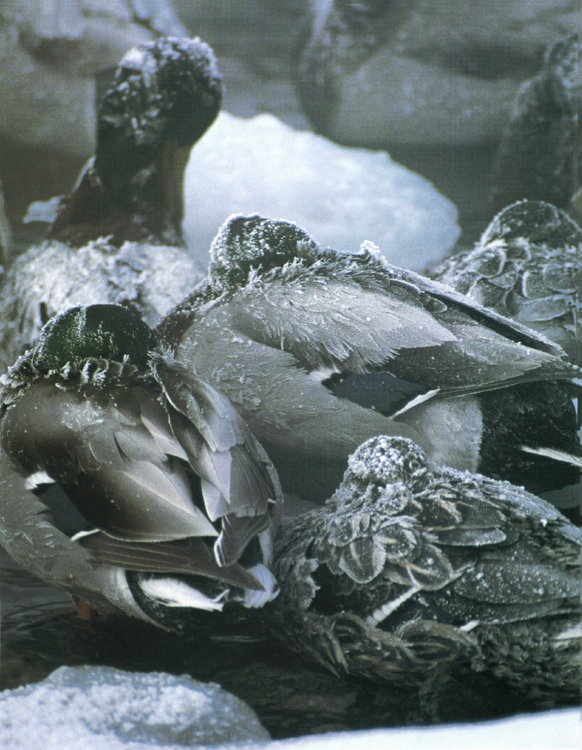
On frigid mornings, mallards try to conserve energy by sleeping or remaining still. By raising their body temperatures, birds can survive minus fifty-degree Fahrenheit readings.

On frigid mornings, mallards try to conserve energy by sleeping or remaining still. By raising their body temperatures, birds can survive minus fifty-degree Fahrenheit readings.
In the spring of the year the small birds of passage appear very suddenly … which is not a little surprising, and no less pleasing: at once the woods, the groves, and meads, are filled with their melody, as if they dropped down from the skies. The reason or probable cause is their setting off with high and fair winds from the southward; for a strong south and southwest wind … never fails bringing millions of these welcome visitors.
—William Bartram
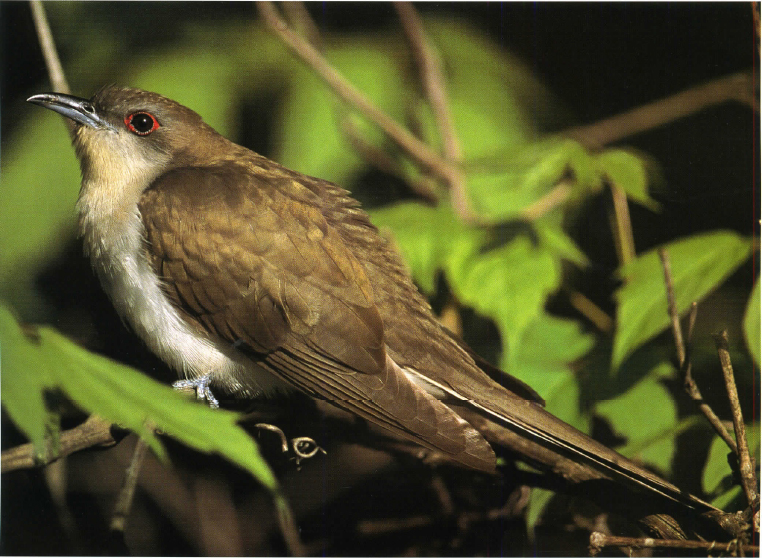
Black-billed cuckoos winter in northern South America south to Ecuador, Peru, and Bolivia and summer in North America mostly east of the Mississippi. They are less numerous than their close kin the yellow-billed cuckoo. Cuckoos are especially fond of hairy caterpillars such as gypsy moth larvae and are more common at the site of outbreaks. Curiously, they can shed their stomach linings to rid themselves of the bristly hairs. Though European cuckoos regularly lay their eggs in other birds’ nests, American species of cuckoo rarely parasitize, and then only each other. Their nests are flimsy affairs, at best.
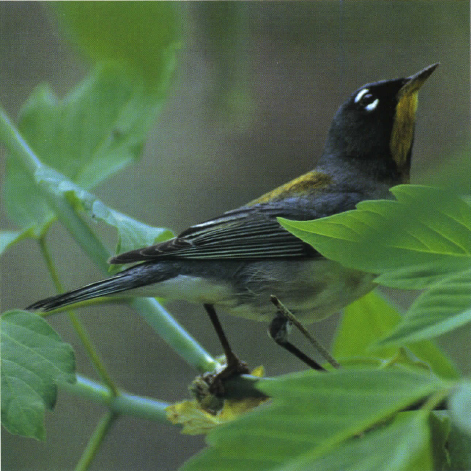
Northern parula warblers are active foragers that hover at the ends of branches and may hang upside down like chickadees. As nesters they are more common in southern states and in Maine and the Maritime provinces. In the south they nest in Spanish moss, in the north in hanging lichens. Few linger around Lake Erie except sparsely on the southern shore, though they may be seen as uncommon migrants to northern Ontario. The yellow breast and dark breast band of this spring male are obscured by foliage, but his white “eye shadow” is clearly visible.
Many thousands of modern birders share the same thrill William Bartram felt two centuries ago as he watched the great surge of songbirds that invades this region in April, May, and early June. Whether one is an expert birder on the watch for rarities or a novice captivated by the first sighting of a luminous scarlet tanager, a “wave day” in May is not likely to be forgotten.
Anyone can share in the magical rush of spring migration by going outside and opening both eyes, even in city green spaces. However, experienced birdwatchers know that Lake Erie weather and geography create “hot spots” where songbirds—thrushes, tanagers, warblers, flycatchers, grosbeaks, and others—mass in exceptional numbers and variety on certain enchanted days.
Migration itself is an immensely complex phenomenon, and explaining in depth the how’s and why’s of it is well beyond the scope of this chapter. There is no simple map or starting gun for the clouds of birds that fly south in late summer and autumn and press north again from warmer climes to breed. In this hemisphere, some migratory birds winter in more clement parts of North America. Many songbirds, however, fly south to the West Indies, Central America, and northern South America and are called “neotropical migrants.”

Here a male summer tanager eats a hornet. Tanagers are bee eaters, and this one is sometimes called “red beebird” in the south where it commonly nests. Summer tanagers do not usually nest north of southern Ohio and Pennsylvania. This one, photographed on the Pelee side of Lake Erie, is an “overflight” and is one of the spring migration’s moments of serendipity.

Warbling vireos are common, especially in upstate New York and southern Ontario, but are more often heard than seen. Migration fallouts caused by changeable weather conditions are a boon to birdwatchers; they may force birds like this one out of the treetops, where they usually lurk, to lower levels for good viewing. Though warbling vireos are sometimes mistaken for warblers, the beak is heavier, and the broad white eye stripe is another field mark.
Ornithologists argue over how migration developed, but they are in general agreement about its advantages. Though the long trip from the wintering grounds to the summer range and back is fraught with danger for individual birds, it bestows a reproductive edge on species. North America offers burgeoning insect populations in spring and summer, and many birds, especially shorebirds, may fly clear up to the Arctic tundra to breed. This is the concentrated protein young birds need to grow and develop. There is also less competition from other birds up north than there is in the tropics and semi-tropics, and the midnight sun provides longer foraging hours. Migrating may be dangerous, but in the game of avian evolution, the payoff is worth the risks.

Rose-breasted grosbeaks are common residents in the Lake Erie area. The flashy costume of this male contrasts with the drab brown of his mate, who looks rather like a large sparrow. These grosbeaks winter from the West Indies and Mexico to northwestern South America and, along with many other songbirds, are termed “neotropical migrants.” Much concern has recently been expressed about these birds’ fates in relation to the clearing of subtropical and tropical forests.

A true jewel of spring and summer forests, this male scarlet tanager is another common migrant in the Lake Erie region. Females, immatures, and adult males in winter are dull green above with dark wings and yellow underparts. While the rose-breasted grosbeak’s song has been likened to “a robin who has taken singing lessons,” the poor scarlet tanager sounds like one with a sore throat.
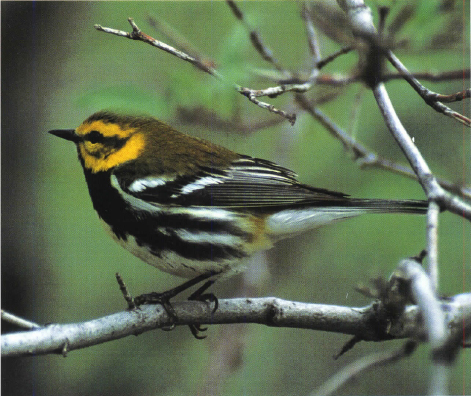
Black-throated green warblers are some of the more common migratory warblers in this area. Note this male’s yellow face, black throat, and dull green crown. Females have a less impressive black cravat. Nesters are more common in Pennsylvania, the Adirondacks in northern New York, and Ontario east of Georgian Bay than right around Lake Erie. This is because they prefer coniferous or mixed coniferous and deciduous forests in their summer range.
A small bird is not a windup toy that leaves its wintering ground and motors on to its nesting range on automatic pilot. True, many aspects of bird migration—such as general direction and distance to be flown—are programmed genetically. For example, many first-year birds make the southward journey from their birthplaces in the north without prior experience or even the company of their parents. However, if a fledgling is to live long enough to reproduce, its behavior must be flexible enough to cope with geographical barriers and shifts in wind, temperature, and other aspects of our changeable and often dangerous weather. To survive, it must learn to make decisions, and on each of these its life may truly depend. Migration is strenuous and exacting work.
What combinations of environment, instinct, and strategy bring these showers of colorful passerines to Lake Erie, and when and where can birders find them? First, birds must be able to locate food, and quickly. Some of the earlier migrants, such as yellow-rumped and palm warblers, can subsist on last year’s remaining fruits and berries until the first big hatch of insects emerges. Others, like thrushes, may probe for worms until insects appear. Most May sojourners, however, have followed the hatch north, one that coincides with opening leaf buds on which the insects themselves feed.
Scientists think that a bird becomes restless and ready to migrate through the interplay of environmental stimuli such as changes in day length and in some cases the workings of an inborn yearly clock (changes in day length do not occur at the equator). Shifts in metabolism at this time enable birds to store masses of fat very rapidly under their skins and around their vital organs. Fat is the fuel for flight, though a bird that has used up its reserves may start burning muscle protein as a last resort. A small bird can travel about 125 miles on one gram of fat.
Once birds have begun their migratory flights, their strategies are as numerous as the species themselves. Some fly by day; some, including most songbirds, by night. Some readily cross large bodies of water, and some, such as blue jays and hawks in the buteo group, will not. Certain birds, like swallows, which swoop after flying insects, feed and migrate simultaneously. Others, like the well-known American golden plover and blackpoll warbler, fly thousands of miles over open ocean on their autumn flights, relying on their fat reserves and tail winds to carry them all the way from Canada’s maritime provinces to South America. As a whole, species follow established patterns of migration, and birds are surprisingly faithful to both their migration rest stops and summer nesting places.
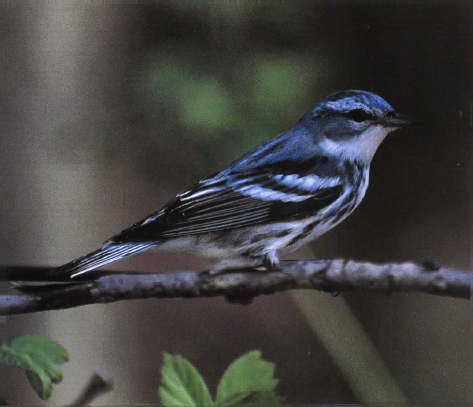
Cerulean warblers usually nest south of Lake Erie, though some travel to Ontario east of the Georgian Bay. Although they appear to be extending their range north and east from centers in West Virginia, eastern Kentucky, and southern Ohio, they are in trouble because they will nest only in deep riverside woods and are very sensitive to fragmentation of breeding habitat. Watchers usually have to crane their necks to see these beautiful creatures, but during migration the birds may literally be at their feet.

A handsome male Cape May warbler shows off his rich chestnut cheeks contrasted in yellow. As with most warblers, the male is much showier than the female, who, in this case, is duller and lacks the chestnut coloring. Since this species nests in spruces, members fly well north of Lake Erie to raise their young and are attracted by outbreaks of spruce budworm. Ironically, one can see a Cape May at Cape May, New Jersey, only during migration.

Birdwatchers try for a big day on the elevated boardwalk at Magee Marsh west of Port Clinton on the south shore of Erie’s western basin. This and Point Pelee National Park on the north shore are two of the best birding locations in North America. Here on the boardwalk and in the neighboring marsh, birders can hope to see a hundred species of birds in a day, including perhaps twenty-five warbler species.
Edwin Way Teale estimated in North with the Spring that the season advances about fifteen miles a day from its beginnings in the far south to its blossoming in the so-called temperate regions. However, most birds’ progress is not such a steady one. William Bartram was right about the importance of “fair winds from the southward.” Birds rest, eat, and stage until they can catch a promising warm front from the south, and then they move in waves. There are several reasons for this. First, such a front promises birds a healthy hatch of insects, the fast food they will need to restore shrinking fat reserves. Second, a tail wind increases birds’ air-to-ground speed and allows them to cover more distance on less fuel. Clear nights also help. Passerines usually fly at night for several reasons: night flight frees the daylight hours for foraging; because the cool air helps dissipate body heat, there is usually less air turbulence then, and they can navigate by the stars (among other methods). They are also safer from predators at night.
Spring migration lasts for at least four months, activity at the western end of Lake Erie usually two to three weeks ahead of that at the other end to the northeast. Conversely, it is two weeks later in autumn. In early March the first wave of raptors, especially harriers, eagles, and the larger buteos like red-shouldered hawks, arrives at the lake. Horned larks and crows —the real early birds—have been moving for some time already. Aldo Leopold’s “goose music” resounds through the marshes, and flights of tundra swans pull in from the Chesapeake.
Other waterfowl begin to come as well. And pugnacious bachelor red-winged blackbirds are setting up territories in the snow-covered marshes hoping to attract females soon to arrive, and the tinkly voices of song sparrows grace the yet-frigid dawns. Around the Ides of March, turkey vultures make their celebrated return to Hinckley, Ohio, rehearsing the role of Shakespeare’s bird of ill omen in Julius Caesar. They are accompanied to Lake Erie by buteo hawks, accipiters, and shorebirds. Later in the month all kinds of waterfowl will be on the move, and many will rest and feed in the marshes and Lake Erie shallows through early April.

Though it nests only rarely around Lake Erie, the white-throated sparrow is abundant in the mixed hardwood and especially the boreal forests farther north. In New England it sings “Old Sam Peabody, Peabody, Peabody,” but north of the border it says, “My Sweet Canada, Canada, Canada.” During migration, birders on Lake Erie can see hundreds on a good day.

This wood thrush is digging for worms as it waits for more insects to hatch. It is not as affected by cold or a late insect hatch as many migrants. Wood thrushes are fond of fruit and have been reported to feed at least some to their nestlings. They like deep, moist deciduous woods, and their lovely songs have been decreasing in North America as a result of the forests’ fragmentation.

Wintering from the southern Atlantic and Gulf Coasts south to Honduras, Nicaragua, and Costa Rica, tree swallows migrate around the Gulf of Mexico (as do other swallows) rather than across it. These pretty birds are tougher than they look, and they arrive in our region earlier than other swallows do. Here a flock of them hunkers down to wait out a cold front. Common nesters from Ohio and Pennsylvania into northern Ontario and Quebec, they use tree cavities or nest boxes, preferably near water.

Baltimore orioles, like thrushes, may resort to digging for worms until insect populations grow. The year 1997 was a good year for orioles in this region: Spring was so late that many stayed to nest near the lake rather than continuing farther north. Orioles’ genus name comes from the Greek word ikteros, meaning jaundice. Did the word refer to the birds’ color, or was it thought that seeing one was a cure for the condition?

Like Cape May warblers, black-throated green warblers, and white-throated sparrows, many veeries move north of Lake Erie to nest in Canada. This thrush likes wet, second-growth deciduous woods where its beautiful downwheeling song—described by some as metallic, by others as liquid and breezy—is commonly heard. It usually searches for insects on the ground and nests on or near it.
Songbirds are moving in April, too, especially the ones headed for far-northern Canada. The first of the great waves brings kinglets, juncos, tree and song sparrows, winter wrens, and brown creepers to the edge of the lake. At the month’s end and in early May, a surge of yellow-rumped warblers, ruby-crowned kinglets, white-throated and white-crowned sparrows, and hermit thrushes appears, as well as black-and-white and palm warblers, flickers, and blue jays. This is a good time to look for a blue-headed vireo. At the end of April, sharp-shinned hawks come through, although not in the numbers they will show in the fall migration. The bulk of the birds arrive in May: whippoorwills, hummingbirds, warbling vireos, magnolia warblers, American redstarts, black-throated blue warblers, orioles, and least flycatchers. Later come yellow-bellied flycatchers, blackpoll and bay breasted warblers, more flycatchers, and waxwings. By the end of May, the great show is usually over, except in very late years.
These birds and the peak of the migration in May can be viewed from many sites on both the southern and northern shores of the inland sea. In a shotgun effect, bunches of birds may visit one place but be absent from another. In addition, Lake Erie’s geography concentrates migrants at certain spots legendary among international birders. The most celebrated of these are in the western basin—Point Pelee on the north shore in Ontario and Magee Marsh on the opposite coast in western Ohio.
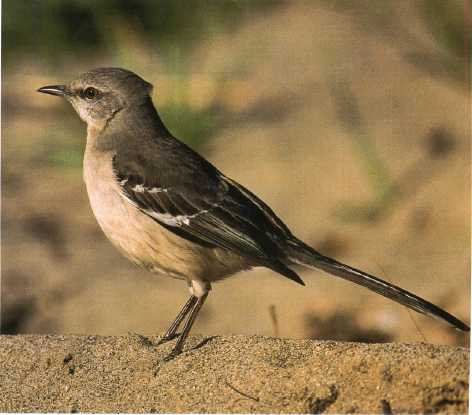
The northern mockingbird is an uncommon migrant and resident in the region. It is slowly expanding its range northward. A wide range of open and partly open habitats suits its needs, and it is often abundant in suburbs farther south. Mockingbirds feed on berries, invertebrates such as sow bugs, and the occasional small vertebrate. Their adaptability suggests that they will increase in this area if winters remain mild.
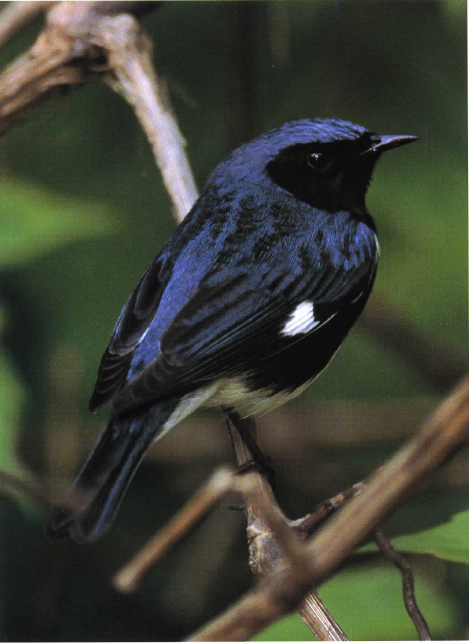
A common migrant, this black-throated blue warbler takes a moment’s rest from insect foraging at Point Pelee before resuming its flight north with the spring. However, the curving shoreline of Lake Erie appears to disorient some birds, and they may find themselves heading south again to Pelee’s tip. This phenomenon is called reverse migration.
Why these sites particularly? For one thing, they are strategically located at the crossroads of two major North American migration routes, branches of the Mississippi and Atlantic flyways. For another, they are placed so that they funnel together birds that are trying to deal with a formidable water barrier. They also provide mature forest, marsh, and thickets for insect foraging in the midst of what is increasingly an agricultural desert, from a bird’s point of view.
For waterbirds such as gulls, terns, and ducks, the lake can be both a highway and a staging ground for rest and feeding. For landbirds, however, it can literally become a watery grave. Songbirds like warblers are quite reluctant to cross the gray-blue water because if the weather changes and the wind turns, if it rains, or if turbulence blows them off course, they may never reach the Canadian shore. This means that if William Bartram’s “high and fair winds from the southward” fail to materialize, a kaleidoscope of small birds lingers on the south shore of the lake until conditions improve. If weather has been cold, with northerly winds blowing for some time, concentrations on the bird trail at Magee Marsh west of Port Clinton, Ohio, may burgeon once the winds shift.
Birders should watch nightly weather reports for low pressure cell locations, anticipated temperatures, and wind directions. In early spring, southwest winds and clear skies are important for raptors. Later, when the songbird waves begin, a low pressure cell in the Arkansas region and expected temperature jumps are good predictors. Warm nights are better than cool ones. In some years, the weather is more cooperative (for humans) than in others. When it is not, migration can be very subtle, because a series of slow-moving fronts may allow birds to fly above or around them, disappointing birders waiting for a major wave. An early spring in which vegetation leafs out earlier farther south enables many birds to gather food as they migrate, and they will not have to stage by the lake in large numbers. Leaves also make them harder to see.
If the weather is not ideal for travel, birds rest, feed, and wait for better conditions at the Magee Marsh bird trail. Although small, the area has good foraging habitat—more than 150 species of songbirds and thirty-eight warbler species have been recorded here where a raised boardwalk makes the area accessible to virtually anyone who loves birds. Magee Marsh and nearby Crane Creek State Park were haunts of my parents, both enthusiastic birdwatchers, and I cherish many memories of tree swallows, great-horned owl nests, basking turtles, and warblers in vivid spring plumage from our repeated visits there.
Many birds filter around the western or eastern ends of the lake after they have fed and rested. Most of them circle west, but dark-eyed juncos and some warblers may round Erie’s eastern end. When the wind shifts to the southwest, however, other tiny adventurers seize their opportunity and take off from the south shore across the lake itself toward Canada. At Point Pelee near Leamington, Ontario, even greater concentrations and varieties of birds can be seen than those staging on the south shore. This remarkable area has recorded about 365 bird species, of which warblers account for more than forty. It is often considered one of the top ten birding locations in North America. Avid birders gather at the tip of the Point Pelee peninsula at dawn to see which weary avian travelers will appear out of the morning haze. These birds have often followed the chain of islands that stretches from north of Port Clinton and Sandusky, Ohio, toward Canada: South, Middle, and North Bass islands, Pelee Island, and the smaller fragments of the archipelago.

Yellow-rumped warblers are early migrants that arrive here in good numbers toward the end of April. Although some winter in the southern United States, many others fly farther south to Mexico and Central America. During the past twenty years, ornithologists have warned about deforestation and its effects on our neotropical migrants. This is a serious concern, although the picture is somewhat more complex: Surveys by the Ohio Department of Natural Resources in the mid-eighties showed that although about one fourth of neotropical migrants had declined, one third remained stable, and 40 percent actually increased.
The largest number of migratory birdwatchers wait at Pelee between about May 10 to May 15. Park records show that approximately 80,000 birders flock to the peninsula in that month each year, a major boon to the area’s economy. (Large banners pronounce “Welcome Birders” on the road to the waterfront in Leamington.) For those who dislike crowds (of humans, that is), Pelee may seem something of a mob scene. Mega camera rigs abound, as well as state-of-the-art spotting scopes. Television camera crews ask men with big rigs and birding hats questions like “What dangers lurk out there for you birders?” They seem a bit disappointed to hear the un-macho replies: “Mostly sunburn and poison ivy. Actually, the main dangers are to the birds, through habitat destruction.” Few people are seen consulting bird guides, the assumption being that one has already memorized them thoroughly.

This savannah sparrow was photographed at Pennsylvania’s Presque Isle State Park. One of the finest birding sites in Erie’s eastern basin, Presque Isle’s miles of sand beach, sand plains, and wetlands attract many spring and fall migrants. Savannah sparrows are common in grasslands, marshes, and other open habitats.
Yet there is a lively sense of comradery here. Experienced birders help novices with identifications. Knots of people gather to see rarities spotted by experienced—or lucky—watchers. Their eyes shine. I remember with special affection the couple who pointed out a golden-winged warbler to me and my husband. “Seeing it was an accident. We were just walking back to our truck. It’s a lifer for us—isn’t it beautiful?” they beamed.
This is the time for gaudy tanagers, grosbeaks, and orioles, birds that seem to be everywhere and that send an ordinary birdwatcher’s heart to fluttering. The experts respond with gentle tolerance when one points them out; bird mavens are after rarer game. Females of ruby-crowned kinglets, white-throated sparrows, yellow-rumped warblers, and Swainson’s thrushes also abound, as well as more unusual species such as blackpoll and mourning warblers. Two sandhill cranes far from their usual territory fly over, necks outstretched, calling with voices that sound like the prairies. Around Memorial Day another wave of birds sweeps in, featuring American redstarts, indigo buntings, vireos and flycatchers, and many female warblers. By mid-June the crowds of both birds and birdwatchers have thinned, with the birds nesting and raising the next generation of migrants, and the birders turning their attention to the breeding birds and beginning to anticipate shorebird migration.
It’s important to note that Point Pelee and Magee Marsh are not the only good places to witness the spring migration drama. In fact, for those who prefer to avoid human crowds, there are Hillman Marsh and Wheatley Provincial Park near Pelee, Rondeau Provincial Park about fifty miles east of Pelee on the lake’s north coast, and Long Point, yet farther east on the same shore near Port Rowan. Sheldon Marsh and Mentor Headlands in Ohio and Presque Isle near Erie, Pennsylvania, on Erie’s south shore, as well as other sites listed in this volume’s appendix, also afford exciting and most satisfying spring birding experiences. Of course, any of these areas will be less populated during the week than on the weekends, and it is certainly wise to visit Pelee during midweek, if possible.
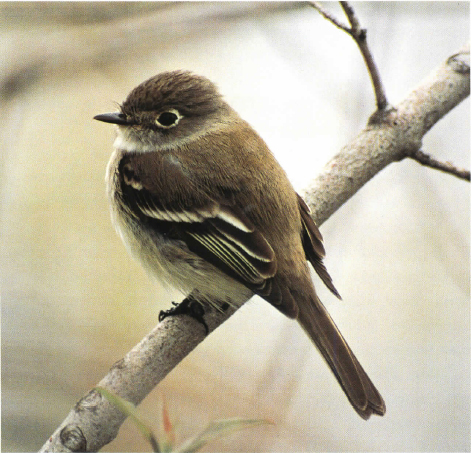
A “chebec” call tips off birders that this is a least flycatcher, one of the five empidonax species to be expected during migration. These small flycatchers are very hard to identify visually, but their respective calls give them away. Least flycatchers, the earliest migrating empids, often arrive at Point Pelee in late April.
What many ardent birders hope to see, at least someday, is not just an ordinary wave day but what is called a “fallout day.” Fallouts happen when the weather is cold, especially at night, and birds are short of food. If a warm front carrying a wave of birds meets a cold front from the north over Lake Erie, the warmer air slips over the cooler, forcing them to fly higher with greater effort. Then it cools down itself. The wearied birds must eventually descend, and the sight of the green spike of Point Pelee thrusting into the perilous waters attracts tenfold numbers of them. If rain accompanies the fronts’ impact, the birds are grounded and, as Tom Powers notes in Great Birding in the Great Lakes, “The birdwatching takes a quantum leap beyond incredible” (146–47). Birdwatchers thrill at the opportunity to see unusual species in double rather than single digits. One birder was heard to say, “It’s just like looking at a bird book, only everything is alive!”
Major fallouts usually take place early in May when the weather is less settled than it is later in the month. The later in May a fallout occurs, the greater variety of species can be seen; a major fallout may happen at this time every four or five years. Small birds can be so exhausted by the time they reach Pelee that they sometimes even land on birders standing at the end of the point. Some, scarcely more than skin, feather, and bone, may be too tired to feed and will die if they cannot. Sometimes they are even seen picking dead insects from spider webs and from the radiators of cars, as was the case during a big warbler die-off in 1996. If the trees have not yet leafed out, the gamble to be first to the nesting grounds can turn deadly. However, if birds make it from the beach sand to the vegetation beyond, and if conditions are reasonable, they will find a diverse habitat of forests, wetlands, and grassy areas in which to forage and recoup their strength for the next leg (so to speak) of their long flight.
It is an irony that birds’ struggles during a fallout can result in so much human pleasure, as Ada Clapham Govan noted in her 1940 book Wings at My Window: “Easter Sunday was a mellow, sunny day, but a blizzard broke that night, catching the migrating hosts in their northward flight and slaying them by thousands and tens of thousands. The noise of that wild storm and a mixed chorus of bird calls outside awakened me at daybreak. Every feeding box was inches deep in snow; yet birds were everywhere, and in spite of the storm, they were singing lustily, joyously, as I had never heard birds sing before” (Eriksson and Pistoriono, 14).
Migrating benefits species that journey from the tropics to raise their young amid the burgeoning summer insects and lesser competition from other birds in the north. But it is fraught with danger for individuals, especially when storms hit without warning. Conflicted as we may feel about the great mortality such gales cause, we who watch these small travelers are the inheritors of joy from their short and strenuous lives. Certainly, avian migration is a major wonder of our natural world, blessing human beings from William Bartram to those of us who watch the “millions of these welcome visitors” around Lake Erie today.
ADDITIONAL READING
Ehrlich, Paul R., David S. Dobkin, and Darryl Wheye, The Birder’s Handbook. New York: Simon and Schuster, 1988.
Eriksson, Paul S. and Alan Pistorino. Treasury of North American Birdlore. Middlebury, Vt.: Paul S. Eriksson, 1987.
Goodwin, Clive E. A Bird-finding Guide to Ontario. Toronto: Univ. of Toronto Press, 1995.
Kerlinger, Paul. How Birds Migrate. Mechanicsburg, Pa.: Stackpole Books, 1995.
Peterson, Roger Tory. Eastern Birds. New York: Houghton-Mifflin, 1980.
Powers, Tom. Great Birding in the Great Lakes. Flint, Mi.: Walloon Press, 1998.